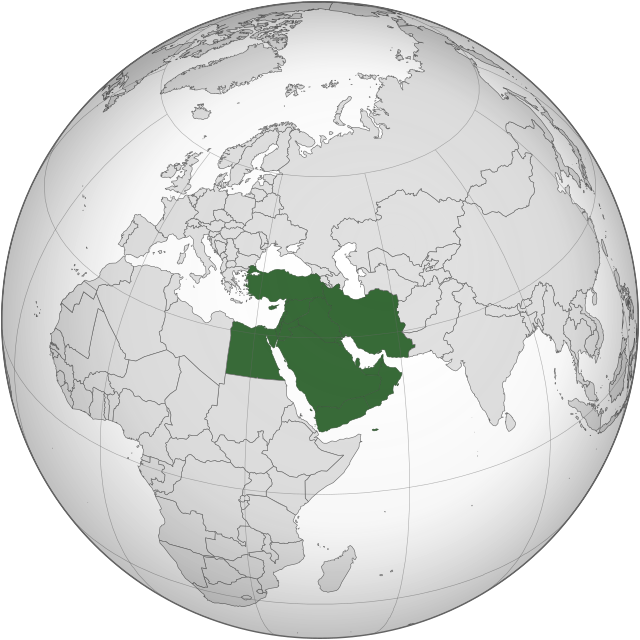Can the Western Perception of the Middle East Evolve Beyond its Perceived Danger?

Map of The Middle East. Photo: WikiMedia
By: Joud Sleilaty / Arab America Contributing Writer
Introduction
The Middle East, a region rich in history, culture, and diversity, has long been a focal point of global attention. Unfortunately, in recent decades, the Western perception of the Middle East has been dominated by images of conflict, terrorism, and instability. This perception, largely shaped by media coverage and geopolitical events, raises an important question: Can the Western perception of the Middle East evolve beyond its perceived danger? In this article, we will explore the factors that have contributed to the prevailing negative perception, the challenges it presents, and the potential for a more nuanced and balanced understanding of this complex region.
The Power of Media in Shaping Perceptions
Media plays a very important role when it comes to shaping the public’s perception of the world. This phenomenon is specifically seen in the case of the Middle East. Television, newspapers, and online platforms have frequently portrayed the region through a narrow lens, emphasizing violence, terrorism, and political instability. This negative portrayal of the region has led to the creation of a stereotype that overshadows the rich cultural heritage, economic potential, and diversity of Middle Easterns.
Geopolitical events, like military interventions and conflicts, have simply reinforced the common belief that the Middle East is an unstable and risky region. The invasion of Iraq in 2003, the long-standing Israeli-Palestinian conflict, and the ongoing Syrian civil war have each added to the feeling of instability. Additionally, the presence of terrorist groups across the region has only deepened the perception of ongoing danger. Western media has consistently covered these events, continuously reinforcing the idea that the Middle East is a region reigned by violence and unrest.
The legacy of iconic images such as burning oil fields during the Gulf War, the September 11th attacks, and the Arab Spring uprisings have left permanent marks on Western perceptions. These events, although significant, do not represent the entirety of the region’s history or its daily life. It is therefore crucial to recognize that the Middle East is not solely defined by conflict and danger; on the contrary, some Middle Eastern countries are even considered to be some of the safest in the world like Qatar, the UAE, Oman, Saudi Arabia, and Bahrain.
The Role of Stereotypes and Prejudice
Stereotypes and prejudice play a significant role in perpetuating negative perceptions of the Middle East. These stereotypes not only obscure the diversity of cultures and beliefs within the region but also contribute to a sense of “otherness” that can lead to discrimination and bias.
Beyond the geopolitical implications, the Western perception of the Middle East has a human cost. It can lead to prejudice and discrimination against Middle Eastern communities living in Western countries. Hate crimes, racial profiling, and the stigmatization of entire communities can result from this skewed perception. Islamophobia, in particular, has become a concerning issue in Western societies, further entrenching negative views of the Middle East and its people. Addressing these biases is essential for fostering a more balanced and empathetic understanding of the region.
Furthermore, the perception of danger can discourage tourism, foreign investment, and cultural exchange with Middle Eastern countries. This can hinder economic development and mutual understanding, perpetuating a cycle of mistrust and ignorance.
Challenges to Evolving Perceptions
Changing deeply ingrained perceptions is a complex and multifaceted challenge. Several factors contribute to the difficulty of shifting Western views of the Middle East:
- Confirmation Bias: People tend to seek out information that confirms their existing beliefs. Those who have long held negative perceptions of the Middle East may be reluctant to consider alternative viewpoints.
- Media Sensationalism: Sensationalism in media reporting often prioritizes dramatic and attention-grabbing stories. Positive developments in the Middle East may receive less coverage than violent incidents, perpetuating the perception of danger.
- Political Interests: Geopolitical interests can shape government narratives and media coverage, further reinforcing negative perceptions for strategic purposes.
- Emotional Impact: Traumatic events, such as acts of terrorism, leave a lasting emotional impact, making it challenging to change perceptions rooted in fear and trauma.
The Potential for Change
Despite the challenges, there are signs of hope and potential for change in Western perceptions of the Middle East:
- Social Media: With the emergence of social media, diverse voices from the Middle East now have a platform to share their perspectives and challenge stereotypes. Videos about Middle Eastern people’s daily lives have been circulating on the internet, encouraging people from all around the world to visit and see the beauty of Middle Eastern countries for themselves.
- Cultural Exchange: Cultural exchange programs, educational initiatives like study abroad programs, and most importantly tourism can bridge divides and foster greater understanding between Westerners and Middle Easterners.
- Peace Initiatives: International efforts to resolve conflicts and promote peace in the region can help shift perceptions from a focus on danger to one on diplomacy and cooperation.
- Media Responsibility: More media outlets have been held accountable during the past years for showing biases and spreading misinformation. Subsequently, they have been taking a more responsible approach to reporting in general, and more specifically, to providing a more balanced view of the Middle East that includes its positive aspects and human stories.
Conclusion
The Western perception of the Middle East as a region synonymous with danger and instability is a complex issue deeply rooted in history, media coverage, and geopolitical factors. While changing these perceptions is challenging, it is not impossible. By recognizing the richness and diversity of the Middle East, challenging stereotypes, and fostering cultural exchange and diplomacy, it is possible to evolve beyond the current perceived danger and develop a more balanced, nuanced, and empathetic understanding of this vital region. In doing so, we can pave the way for more constructive engagement, peaceful relations, and a brighter future for all involved.
Check out Arab America’s blog here!








